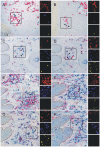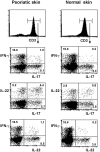Overrepresentation of IL-17A and IL-22 producing CD8 T cells in lesional skin suggests their involvement in the pathogenesis of psoriasis
- PMID: 21124836
- PMCID: PMC2991333
- DOI: 10.1371/journal.pone.0014108
Overrepresentation of IL-17A and IL-22 producing CD8 T cells in lesional skin suggests their involvement in the pathogenesis of psoriasis
Abstract
Background: Although recent studies indicate a crucial role for IL-17A and IL-22 producing T cells in the pathogenesis of psoriasis, limited information is available on their frequency and heterogeneity and their distribution in skin in situ.
Methodology/principal findings: By spectral imaging analysis of double-stained skin sections we demonstrated that IL-17 was mainly expressed by mast cells and neutrophils and IL-22 by macrophages and dendritic cells. Only an occasional IL-17(pos), but no IL-22(pos) T cell could be detected in psoriatic skin, whereas neither of these cytokines was expressed by T cells in normal skin. However, examination of in vitro-activated T cells by flow cytometry revealed that substantial percentages of skin-derived CD4 and CD8 T cells were able to produce IL-17A alone or together with IL-22 (i.e. Th17 and Tc17, respectively) or to produce IL-22 in absence of IL-17A and IFN-γ (i.e. Th22 and Tc22, respectively). Remarkably, a significant proportional rise in Tc17 and Tc22 cells, but not in Th17 and Th22 cells, was found in T cells isolated from psoriatic versus normal skin. Interestingly, we found IL-22 single-producers in many skin-derived IL-17A(pos) CD4 and CD8 T cell clones, suggesting that in vivo IL-22 single-producers may arise from IL-17A(pos) T cells as well.
Conclusions/significance: The increased presence of Tc17 and Tc22 cells in lesional psoriatic skin suggests that these types of CD8 T cells play a significant role in the pathogenesis of psoriasis. As part of the skin-derived IL-17A(pos) CD4 and CD8 T clones developed into IL-22 single-producers, this demonstrates plasticity in their cytokine production profile and suggests a developmental relationship between Th17 and Th22 cells and between Tc17 and Tc22 cells.
Conflict of interest statement
Figures





References
-
- Teunissen MB, Piskin G, Res PC, de Groot M, Picavet DI, et al. State of the art in the immunopathogenesis of psoriasis. G Ital Dermatol Venereol. 2007;142:229–242.
-
- Bos JD, de Rie MA, Teunissen MB, Piskin G. Psoriasis: dysregulation of innate immunity. Br J Dermatol. 2005;152:1098–1107. - PubMed
-
- Bos JD. Psoriasis, innate immunity, and gene pools. J Am Acad Dermatol. 2007;56:468–471. - PubMed
-
- Nickoloff BJ, Xin H, Nestle FO, Qin JZ. The cytokine and chemokine network in psoriasis. Clin Dermatol. 2007;25:568–573. - PubMed
-
- Austin LM, Ozawa M, Kikuchi T, Walters IB, Krueger JG. The majority of epidermal T cells in Psoriasis vulgaris lesions can produce type 1 cytokines, interferon-gamma, interleukin-2, and tumor necrosis factor-alpha, defining TC1 (cytotoxic T lymphocyte) and TH1 effector populations: a type 1 differentiation bias is also measured in circulating blood T cells in psoriatic patients. J Invest Dermatol. 1999;113:752–759. - PubMed
MeSH terms
Substances
LinkOut - more resources
Full Text Sources
Other Literature Sources
Medical
Research Materials

